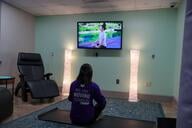You have /5 articles left.
Sign up for a free account or log in.
In my view, two of the important pillars of effective instruction are consistency and flexibility.
These pillars are so important because the great enemy of effective instruction is disruption.
In any given pre-pandemic semester, any number of individual students will experience a disruption to their ability to access and engage with their own education. Illness, family problems, relationship problems, housing insecurity, you name it, there’s students on campus whose educations are being disrupted in significant ways.
We tend to accept these things as inevitable (though for things like housing insecurity, we shouldn’t), while trying to mitigate the effects of disruption through the structure of our courses and consistency of instruction. The course is there for the student when they’re able to get back to it. The flexibility – in my view – is necessary because I want students to be able to pick up where they left off, rather than seeing a cascading series of negative events that will compound the problems caused by the temporary disruption.
Back in June as I fretted over campus re-opening plans, I centered those worries on the likelihood and problem of disruption. Here, I was thinking about the previous spring’s events where the sudden shift to emergency remote distance instruction was obviously hugely disruptive. Avoiding scenarios where something similar happened seemed to me like the first order of business.
The events at UNC-Chapel Hill were pretty much the worst case scenario, another sudden pivot sending residential students back home. However, that worst case scenario was not borne out everywhere, and some schools seem to have managed to sustain on-campus operations, even in the face of massive numbers of COVID-positive students.
But my sense is that disruption has been endemic, even at those places that have avoided the worst case scenario. Certainly thousands of infected students who are (hopefully) quarantining is disruptive in and of itself, but the potential for disruption goes beyond this.
Kevin Gannon’s invaluable accounting of “our HyFlex Experiment” illustrates tensions between flexibility and disruption in our pandemic age. On the one hand, HyFlex which allows for in-person or online engagement, synchronous or asynchronous, is supposed to make it easier for students to access their courses. On the other hand, the technology and support necessary for an instructor to conduct a HyFlex course without experiencing nearly moment-to-moment disruption are not present in the vast majority of situations.
For most, a HyFlex course is a near guarantee of disruption. Gannon puts it this way, “I’ve been teaching college classes for 23 years, and there have been times this semester when I’ve felt less like a teacher and more like one of those circus performers spinning stacks of plates and cups on my arms and head — except in my case, there are many more drops and crashes.”
As Gannon points out, HyFlex originated in a specific place for a specific reason, an education technology graduate problem for working professionals with day jobs where the mode was an attempt to help the students minimize the disruption to their lives. There it made sense.
On the other hand, HyFlex as a rationale for preserving some semblance of face-to-face instruction so you can say you’re offering face-to-face instruction is not rooted in pedagogical concerns. It is another example of what I identify as privileging operations over mission. It’s more important to resemble what people expect from college than it is to actually do the work of teaching and learning that’s possible during a pandemic.
This isn’t to say that HyFlex isn’t useful, just that the choice to go HyFlex needs to be considered in the context of avoiding disruption. In some, perhaps most cases, it may be more disruptive. Giving students a more limited, but also consistent choice may actually be beneficial when it comes to their learning.
A recent study from Ithaka S+R on “Student and Faculty Experiences with Emergency Remote Learning in Spring 2020” further illustrates the challenges of dealing with disruption. The report puts helpful specifics to much of what we suspect, that in the face of disruption, everyone – faculty, students, staff – needs more support.
The type of support ranges from specific technical issues – more laptops, better software access, improved wifi – to more complicated emotional issues, like how to deal with the toll of physical separation.
The study isn’t quite explicit in declaring that the enemy is disruption, but it is the upshot of many of their findings. Their recommendations (very much worth your time) are focused on filling the gaps caused by disruption.
As plans develop for future semesters, I’m more convinced than ever that disruption is still our primary foe. If our best possible shot at helping students learn is the goal, minimizing our chances for disruption needs to be our primary concern.
What minimal risk of disruption looks like on individual campuses will vary, but for the sake of the students, this is where we should start.

